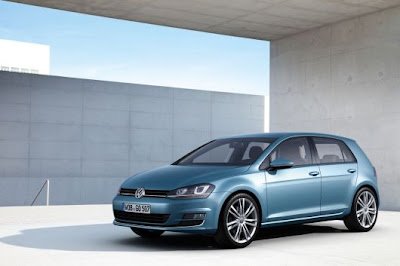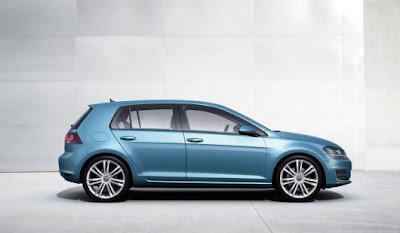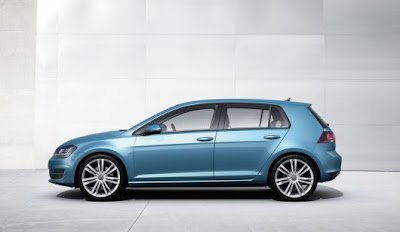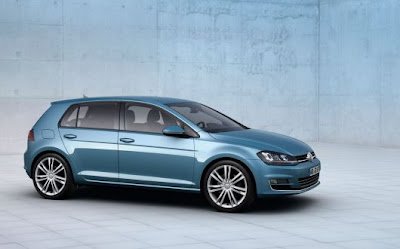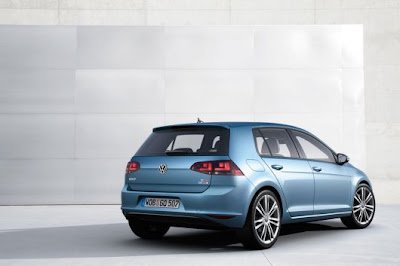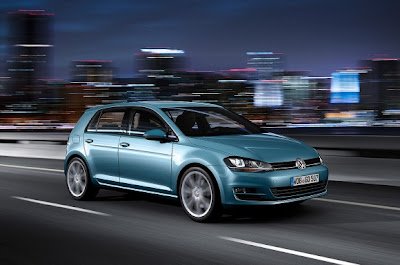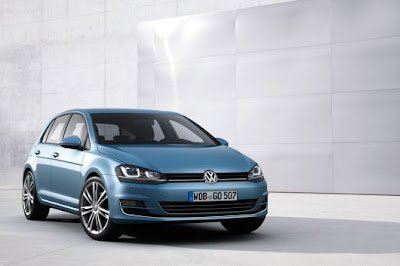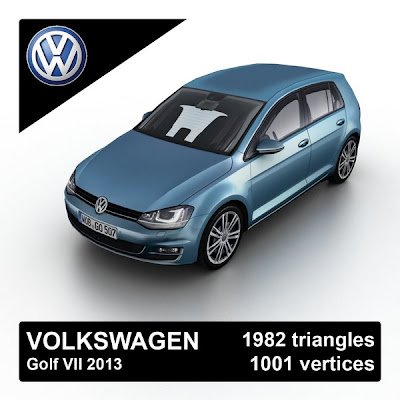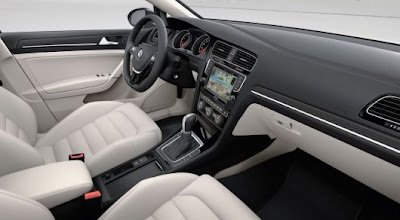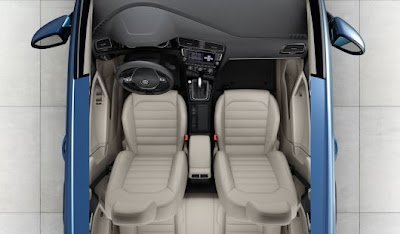Premium proportions.
“The language of form,” says Bischoff, “is logical, solid, product-focussed, pure and precise and reflects the brand’s design DNA as a perfect model of creativity. The base architecture of the new Golf is therefore unmistakable. It feels uncomplicated, strong, comprehensible, reliable and safe. Starting with the pure element of this clear base architecture, details such as the economical use and placement of sculptural lines are more like fine nuances. Also extremely important is the fact that the proportions of the Golf Mk7 have changed significantly, making the car look more premium-class than ever.” Marc Lichte, leading designer for the exterior explains: “The proportions have changed so significantly because we have taken advantage here of the Modular Transverse Matrix. The front wheels, for example, have moved 43 millimetres further forward. The front overhang is therefore shorter and at the same time the bonnet looks longer.” Klaus Bischoff confirms this: “Visually, the passenger compartment has moved towards the rear, creating what is called a ‘car-backward’ impression. That’s what we call the proportions of premium-class vehicles, on which the bonnet is long and the passenger compartment a long way towards the back. On the new Golf we thus have proportions that you otherwise only get in higher-class segments of the market.”
Silhouette with powerful lines. Marc Lichte: “And we sought to underline these modified proportions with design elements. Below the door handles we have integrated the now clearly visible, very sharp character line. While this line is broken by the wheel arches, it is otherwise continuous and is stylistically reflected in the chrome bars of the radiator grille and headlights and at the back in the white lateral bars of the rear light clusters. Set deep down all the way around, this line lowers the apparent centre of gravity and makes the car appear more solid on the road. Another important element is the new line along the side shoulder directly below the windows. This line starts at the front in the headlight, then glides under the wing mirror, which is positioned right on the line, all the way through to the rear side window, underling the premium proportions of the new Golf.”
One of the world’s most familiar C-pillar. Klaus Bischoff adds: “The silhouette’s character is particularly defined by two further elements – typical Golf elements: the C-pillars and the roofline. Looking at the car from the side the precisely contoured C-pillar catches the eye, resembling the drawn string of a bow and thus giving the Golf a speedy appearance even when static, while at the same time paying homage to the Golf Mk2 and Mk4 – both design icons. The contour of the roofline has also been completely redesigned. Here too – above the side windows – the Golf displays a further line, which runs from the roof-edge spoiler right through to the A-pillars. In their interplay with each other the light-refracting lines, the apparently flying wing mirrors and the striking C-pillars produce a very muscular, sporty and self-assured feel.”
Front section clearly Volkswagen and also clearly Golf. The Volkswagen design DNA manifests itself in a ‘face’ that has appealing features. In addition, in the same way as on the first Golf, it defines horizontally balanced elements that create a certain width. Together this produces – especially in the case of the new Golf with its slightly upward sweeping headlights – a front section that is instantly recognisable in any rear view mirror as that of a Volkswagen. Compared to its predecessor, the new Golf also displays completely restructured modulation of its surfaces. While on the Golf Mk6 the wings were higher than the bonnet, this is now the other way round.
Rear section scores visually and in detail. All new and yet familiar – that applies to the back as well. Typical elements here include the clear geometry of the rear lights, the rear window stretching all the way to the C-pillars and the large homogenous surface around the Volkswagen badge. In the hunt for perfection, however, all of that would – in typical Volkswagen fashion – be considered too little in terms of detail if it did not also provide some very tangible benefits. And included among these in the case of the new Golf is the fact that, even with all the great aesthetics, the designers have succeeded in reducing the height of the boot sill to just 665 mm. That is the best figure in this entire segment of the market and another example of perfection in attention to detail – a side note that gains in significance the first time a customer goes shopping in their new Golf.
Lightweight design – searching for every gram.
Saving up to 100 kg in weight is a complex task, especially in the compact class. The fact is that not every carmaker is pursuing the route of lightweight design – searching for every last gram – as methodically or thoroughly as Volkswagen. The reason is clear: intensive research and development work costs money. The fact that despite its higher specification the base price of the seventh generation Golf has not gone up by a single cent is a reflection of the innovative power of this brand.
Overall vehicle – how savings add up to 100 kg.
If you divide the Golf up into the primary areas of electrical equipment, engines, running gear and superstructure, an analysis yields – depending on model, specification and type of engine – the following split for the weight reduction:
• Up to -6.0 kg = Electrical
• Up to -40.0 kg = Engines
• Up to -26.0 kg = Running gear
• Up to -37.0 kg = Superstructure
In purely mathematical terms the total potential saving is thus even as much as 109 kilograms. Due, however, to the configuration options that can be implemented in practice, the maximum achieved in any one vehicle is 100 kg. The greatest weight reduction is achieved from the engines and superstructure. It is particularly interesting to look into the details of the superstructure (car body and interior) and the 37 kilograms saved here, as it shows how lightweight design that is compatible with large-scale production can be achieved in 2012.
Dashboard.
0.4 kg doesn’t sound like much. But this is where perfection in the details comes into play. If you ignore 0.4 kg, you will never ultimately achieve 100 kg. Volkswagen not only succeeded in making the dashboard 20 per cent lighter thanks to a new thermoplastic foam injection process – the load-bearing, sandwich-like structure beneath the elegant surface consists of this material – but also in making it 20 per cent more rigid at the same time.
Module cross-member.
1.4 kg here also contributes towards overcoming the upward weight spiral. Mounted on the module cross-member are both the steering gear and the dashboard. Altogether the cross-member weighs 5.8 kg. The reduction in weight was achieved with a lightweight construction concept using steel components. Based on an analysis by Finite Element Method (FEM) computations, the structure of the module cross-member was designed to be as light as possible and as strong as necessary. Optimal steel wall thicknesses and structural design measures, such as specially worked-in corrugations, improved the rigidity of the cross-member, while also reducing its weight by the aforementioned 1.4 kg. Utilising methods such as the Finite Element Method, engineers at Volkswagen are essentially emulating examples found in nature, where the natural world is able to attain an astonishing ratio between the cross-section of a part’s structure and its rigidity – e.g. in a stalk of grass or grain. That is the right way to go.
Air conditioning.
The Golf’s entire air-conditioning system has been redesigned and is 2.7 kg lighter. Independent of its weight, all of the Golf air-conditioning units with their highly efficient refrigerant cycles set standards in terms of comfort and efficiency. That’s because they run very quietly (up to 5 dB(A) lower), reach the desired temperature significantly faster and are very energy-efficient (up to 4 Amps less) due to a new type of blower control with intelligent climate control. The 2.7 kg weight reduction is achieved by such design modifications as optimised thickness of various system components walls, reduced diameters of pressure lines, a new fastening system and a weight-optimised high-performance heat exchanger.
Seating system.
Along with numerous minor modifications to the seats, weight was reduced – especially from the rear backrests – to save a total of up to 7 kg. Once again, the Finite Element Method (FEM) and high-strength steels combined with laser welding made it possible to optimize wall thicknesses and profile geometries. Engineers achieved weight savings of over 15 per cent in this way and by using lighter backrest latch mechanisms.
Body.
The body must be strong and rigid to guarantee optimal safety and maximum comfort. Nonetheless, its structure should remain athletically lean, so that the overall vehicle is light and efficient. Strong yet lightweight – harmonising these two parameters continues to be one of the greatest challenges in the automotive world. Especially when the car – like the Golf – needs to be an affordable car for millions of people. Highly expensive materials like aluminium, magnesium or even carbon-fibre are therefore excluded in this segment – at least when they are used in grand style. That is why Volkswagen relies on the synergies of the Modular Transverse Matrix (MQB), innovative utilisation of high-strength steels and advanced production methods. A 23 kg reduction in weight with more stringent crash and rigidity requirements as well as larger vehicle dimensions – achieved without additional costs – demonstrate that this can be done successfully.
Engines – fuel consumption drastically reduced.
The fact that the new Golf is conceptually based on the Modular Transverse Matrix has far-reaching consequences: this Golf has been completely redesigned in practically every area – the vehicle body, the interior, the engines, all of the information and entertainment systems and the numerous new driver assistance systems. Elements carried forward were in the main technical features that were already future proof in the previous model – for instance the six- and seven-speed direct shift gearbox (DSG). Everything else is new. And that ‘new’ really means new! For example, the engines: none of them was carried forward unmodified. To be precise, Volkswagen developed two completely new engine generations for the Golf. Every version is fitted as standard with a Stop/Start system (reducing fuel consumption by up to four per cent) and brake energy recovery mode (cutting CO2 by around four per cent). With all measures combined it was possible to reduce CO2 emissions by up to 23 per cent.
Driver profile selection.
For the first time the Golf is now also being offered with a driver profile selection system, a tool with which forward-thinking drivers can achieve a particularly efficient style of driving. There are a total of four – and, in combination with DCC (adaptive chassis control), five – driving modes available: Eco, Sport, Normal, Individual and, in combination with DCC, Comfort. In the Eco driving profile engine management, air conditioning and other ancillary systems are controlled such that optimum fuel consumption is achieved. In addition on vehicles with DSG when driving in Eco mode there is a ‘coasting’ function available. If a driver takes their foot off the accelerator – for example, when drawing up to traffic lights or on downhill stretches – the DSG disengages and the engine idles. As long as the driver drives appropriately, the Golf’s kinetic energy can thus be put to optimum use.
The petrol engines.
The petrol engines used are exclusively turbocharged and direct-injection TSI engines (four valves, four cylinders). The petrol engines offered at launch on the new Golf deliver 63 kW / 85 PS and 103 kW / 140 PS. Even the base model excels with an average fuel consumption figure of just 4.9 l/100km (equivalent to 113 g/km of CO2) – 0.6 litres less than the previous corresponding model. For the first time there will also be a Golf with cylinder cut-off (ACT active cylinder management). The model fitted with this is a 140 PS TSI, which already satisfies the future EU6 standard. Average fuel consumption is just 4.8 l/100km (112 g/km CO2). By way of comparison: the 18 PS weaker corresponding engine in the already fuel-efficient previous model (90 kW / 122 PS) consumed 6.2 l/100km (144 g/km CO2).
ACT – how it works in detail.
The 1.4 TSI engine’s active cylinder management (ACT) is truly pioneering. Volkswagen is the world’s first manufacturer to install this fuel-saving technological innovation in a mass-market four-cylinder engine. In the case of the new Golf Mk7 this is the 103 kW / 140 PS TSI. The principle of the active cylinder management system: when the load on the engine is low or moderate, two cylinders get shut down, thus reducing fuel consumption in the EU driving cycle by 0.4 l/100km. The cut-off system becomes active between 1,400 and 4,000 rpm at a torque level of up to 85Nm.
The diesel engines.
Everything is also new on the diesel front. The diesel injection engines, also four-cylinder, four-valve versions and here too generally turbocharged, initially deliver 77 kW / 105 PS and 110 kW / 150 PS. Just how efficiently the diesel engines work in the new Golf is shown by the TDI base model with 105 PS and average fuel consumption of just 3.8 l/100km (99 g/km CO2). The Golf Mk6 achieved this figure only with the BlueMotion model, not however with the base model as is the case with the new Golf. In addition, the Golf’s 150 PS TDI is also extremely efficient, as underlined by its average fuel consumption of 4.1 l/100km (106 g/km CO2). The best figures are ultimately delivered once again by the Golf BlueMotion: making thorough use of all the individual solutions in Volkswagen’s technological toolkit, the new Golf BlueMotion emits just 85 g/km of CO2 and consumes on average only 3.2 litres of diesel per 100 kilometres, thus setting new standards – a typical example of Volkswagen’s innovative strength, demonstrating, after all, that the company always incorporates the findings of one BlueMotion generation into the next production model and thus delivers constant enhancements.
Innovations – democratising high-tech.
The new Golf is the first car in the compact class in which – despite significant gains in comfort and safety – the weight of the car has been reduced by up to 100 kg. This fact underscores Volkswagen’s success in the mass production of progressive automobiles. In parallel, an armada of new technologies substantiates the innovative power of the brand in the compact class. In the Golf, these technologies are more attainable for more people than ever before.
New systems – optimised safety and convenience.
New assistance systems include the multi-collision brake – the Volkswagen Group is the only carmaker in the world to implement such a system as standard in a compact car – a proactive occupant protection system, standard XDS electronic differential lock (as found in the previous-generation Golf GTI), ACC adaptive cruise control plus Front Assist and a City Emergency Braking function, Lane Assist lane-keeping assistant, fatigue detection, traffic sign recognition and the latest generation of the automatic parking assistant ParkAssist including OPS (360 degree display) as well as the automated light functions Light Assist and Dynamic Light Assist. There are other new technologies as well, such as progressive steering (optimised dynamic performance and better comfort), selection of driving profile with five modes (‘Eco’, ‘Sport’, ‘Normal’, ‘Individual’ and, in combination with DCC, ‘Comfort’), an electronic parking brake, a newly developed ergonomic sport seat (ergoActive seat), a guard against using the wrong fuel in the diesels, a new climate comfort windscreen that is also a first in this segment and a new generation of information and entertainment systems.
Assistance systems – automatic protection.
Multi-collision braking system. An innovative new feature is the Golf’s multi-collision braking system, which has already won a safety innovation award from Germany’s largest automobile club (ADAC). Background: studies in accident research have found that approximately one-fourth of all traffic accidents involving personal injury are multiple-collision accidents – what is meant here is that there is a second impact after the initial collision.
The multi-collision braking system automatically brakes the vehicle when it is involved in an accident in order to significantly reduce its residual kinetic energy. Triggering of the multi-collision braking system is based on detection of a primary collision by the airbag sensors. Vehicle braking by means of the multi-collision braking system is limited by the ESC control unit to a maximum deceleration rate of 0.6 g. This value is the same as the deceleration level provided by Front Assist. The driver’s ability to control the car is thus assured even when automatic braking is triggered.
The driver can ‘override’ the multi-collision braking system at any time; for example, if the system recognises that the driver is accelerating, it gets disabled. The automatic system is also deactivated if the driver initiates hard braking at an even higher rate of deceleration. In essence, the multi-collision braking system applies the brakes until a vehicle speed of 10 km/h is reached. This residual vehicle speed can be used to steer to a safe location after the braking process.
Proactive occupant protection (PreCrash).
Proactive occupant protection is a typical example of a technology that is being transferred from the luxury class to the compact class. Volkswagen first implemented the proactive occupant protection system in the Touareg. Now the system is making its debut in the Golf, making it one of the few vehicles in its class anywhere in the world to offer such a protection system.
If the proactive occupant protection system detects a potential accident situation – such as by the initiation of hard braking via an activated brake assistant – the seatbelts of the driver and front passenger are automatically pre-tensioned to ensure the best possible protection by the airbag and belt system. When a highly critical and unstable driving situation is detected – such as severe oversteer or understeer with ESC intervention – the side windows (except for a small gap) and sunroof are closed. That’s because the head and side airbags offer optimal support and thereby achieve their best possible effectiveness with windows and sunroof almost fully closed.
Adaptive cruise control.
Until now, adaptive cruise control (ACC) was reserved for vehicles in higher segments such as the Volkswagen CC or Phaeton. Now ACC has arrived in the compact class with the Golf. The system uses a radar sensor integrated into the front of the car. ACC operates over a speed range from 30 to 160km/h with a manual gearbox and from 0 to 160km/h with DSG (dual clutch gearbox). On vehicles with DSG the Adaptive Cruise Control intervenes to such extent that depending on the situation the car gets slowed to a standstill and in Stop-and-Go mode automatically pulls away. ACC maintains a preselected speed and a defined distance and automatically brakes or accelerates in flowing traffic. The system dynamics can by individually varied by selecting one of the driving programmes from the driver profile selector available as an option on the new Golf.
Front Assist.
Front Assist works like ACC with the radar sensor integrated into the front of the car, which permanently monitors the distance to the traffic ahead. Even with ACC switched off, Front Assist helps the driver in critical situations by preconditioning the brake system and alerting the driver by means of visual and audible warnings to any required reaction. If the driver fails to brake hard enough, the system automatically generates sufficient braking force to avoid a collision. Should the driver, meanwhile, not react at all, Front Assist automatically slows the car so that under optimum conditions the speed of any impact is minimised. The system also assists the driver by providing a warning if the car is getting too close to the vehicle in front. The new City Emergency Braking function is part of Front Assist.
City Emergency Braking function.
The City Emergency Braking function, now available for the Golf for the first time, is a system extension of Front Assist and scans via radar sensor the area in front of the car. The new system works at speeds below 30 km/h. If the car is in danger of collision with a vehicle driving or parked up ahead and the driver fails to react, the brake system gets preconditioned in the same way as with Front Assist. If necessary, the City Emergency Braking function then initiates full application of the brakes in order to reduce the severity of the impact. In addition, if the driver fails to press the brake pedal sufficiently, the system will assist with maximum braking power.
Fatigue detection.
This system, which was first introduced in the current Passat, detects waning driver concentration and warns the driver with an acoustic signal lasting five seconds. A visual message also appears on the instrument cluster recommending taking a break from driving. If the driver does not take a break within the next 15 minutes, the warning is repeated once. At the beginning of each trip, the system analyses a range of factors, including the driver’s characteristic steering behaviour. Once under way, the fatigue detection system continually evaluates signals such as steering angle. If monitored parameters indicate a deviation from the steering behaviour recorded at the beginning of the trip, then visual and acoustic warnings are produced. Independent of this monitoring, whenever the system is activated it recommends a driving break to the driver after 4 hours of continuous driving.
Lane Assist.
In the Golf, this camera-based lane-keeping assistant with steering intervention operates with extended functionality: adaptive lane tracking. If desired, the system – used for the first time in the Golf – can now also maintain continuous tracking support, which optimizes comfort and convenience. In addition, where necessary Lane Assist will correct the driver’s steering: as soon as it becomes evident that the driver is leaving the driving lane or is driving over the lane markings without setting the direction indicator, the system gently steers the other way.
Convenience systems – steering, braking, seeing.
Progressive steering. Conventional steering systems operate with a constant gear ratio. However, the new optional steering system in the Golf operates with a progressive gear ratio. This noticeably reduces steering work in manoeuvring and parking. On country roads with lots of bends and in turning, meanwhile, the driver will notice a gain in dynamic performance due to the more direct gearing; the driver also does not need to turn the wheel as much.
Technically, progressive steering differs from the basic steering system by the rack and pinion’s variable tooth spacing and a more powerful electric motor. Its functional difference: unlike with constant steering ratios, which by necessity always represent a compromise between dynamic performance and comfort, here the steering rack’s toothing is modified by the steering stroke. As a result, the transition between indirect steering behaviour in the mid-range (straight-line driving) and direct steering behaviour at larger steering wheel angles is designed to be progressive, which, as mentioned above, enables significantly more agile steering behaviour in dynamic driving situations. Parking the car thus becomes more comfortable, as the wheel needs to be turned less.
Variable ratios have long been known in the area of hydraulic steering systems; however, the tuning of such a steering system is subject to very tight limits, so that the driver is not overtaxed by the transitional behaviour. With the Golf’s new progressive steering system the situation is completely different: the combination of the steering rack’s progressive steering ratio and the tuning potential of an electro-mechanical steering system is systematically exploited in the Golf to realise optimised steering behaviour that is sporty yet practical in everyday driving.
Electric parking brake.
For drivers of larger Volkswagen cars, such as the Passat or Tiguan, the electric parking brake is already taken for granted. Now, this handbrake is also making its way into the Golf. Instead of a handbrake lever, there is a main control switch plus an Auto Hold switch on the centre console. The electric parking brake offers numerous advantages: eliminating the conventional hand-brake frees up more space on the centre console; in addition, the brake is automatically released when driving off, making hill starts easier. Last but not least, the Auto Hold function prevents unintentional rolling from a standstill position.
Dynamic Light Assist.
Via a camera on the windscreen, the system analyses the traffic ahead and the oncoming traffic. Based on this data, the main beam automatically comes on at speeds of over 65 km/h and stays on. This is how Dynamic Light Assist works: with the help of the camera the system masks the main beam modules of the bi-xenon headlights with dynamic cornering lights only in those areas that it calculates could potentially disturb other road users. This function is technically implemented by a pivoting masking aperture between the reflector with the xenon filament and the lens. Along with lateral swivelling of the entire module and independent control of the left and right headlights, this additional aperture geometry is able to mask the light source and thereby avoid dazzling traffic ahead or any oncoming traffic.
Light Assist.
For models with headlights with no dynamic cornering light, the base version of the automatic main beam assistant is available. Light Assist analyses traffic ahead and oncoming traffic – via a camera in the windscreen – and automatically controls activation and deactivation of the main beam (at 65 km/h and above).
Road sign recognition.
Road sign recognition initially made its debut in the Phaeton. In the new Golf it will be available in combination with a satellite navigation system. If via a camera integrated in the windscreen near to the rear-view mirror the recognition system recognises any speed limit or ‘No overtaking’ signs, up to three of these will get shown on the combined instrument panel in front of the driver and on the navigation system’s display. This will also include all additional information and the signs will appear in a logical order: ones that always apply (e.g. a ‘130’ km/h speed limit) get shown in first place, while signs that only apply at certain times (e.g. ‘80 when wet’) appear in second place. If the rain sensor registers that it is starting to rain, the traffic sign that now comes into force, i.e. the ‘When wet’ sign, moves up into first place.
Park Assist 2.0.
The latest version of the parking assistance system now facilitates not only assisted parking parallel to the carriageway, but also reverse parking at right angles to the road. In addition, Park Assist 2.0 is also equipped with a braking and parking space exit function. The system can be activated at speeds of up to 40 km/h by pressing a button on the centre console. Using the indicators, the driver selects the side on which the car is to be parked. If, using the ultrasound sensors, Park Assist detects a large enough parking space (a maneuvering distance of 40 cm front and back is sufficient), the assisted parking can begin: having put the vehicle into reverse, all the driver has to do is operate the accelerator and brake. The car takes care of the steering. Beeps and visual information on the multifunction display assist the driver. If a collision is looming, the system can also actively apply the vehicle’s brakes.


